Go Here to Read this Fast! The most common AirPods problems and how to fix them
Originally appeared here:
The most common AirPods problems and how to fix them
Go Here to Read this Fast! The most common AirPods problems and how to fix them
Originally appeared here:
The most common AirPods problems and how to fix them



Differential equations are one of the protagonists in physical sciences, with vast applications in engineering, biology, economy, and even social sciences. Roughly speaking, they tell us how a quantity varies in time (or some other parameter, but usually we are interested in time variations). We can understand how a population, or a stock price, or even how the opinion of some society towards certain themes changes over time.
Typically, the methods used to solve DEs are not analytical (i.e. there is no “closed formula” for the solution) and we have to resource to numerical methods. However, numerical methods can be expensive from a computational standpoint, and worse than that: the accumulated error can be significantly large.
This article will showcase how a Neural Network can be a valuable ally to solve a differential equation, and how we can borrow concepts from Physics-Informed Neural Networks to tackle the question: can we use a machine learning approach to solve a DE?
In this section, I will talk about Physics-Informed Neural Networks very briefly. I suppose you know the “neural network” part, but what makes them be informed by physics? Well, they are not exactly informed by physics, but rather by a (differential) equation.
Usually, neural networks are trained to find patterns and figure out what’s going on with a set of training data. However, when you train a neural network to obey the behavior of your training data and hopefully fit unseen data, your model is highly dependent on the data itself, and not on the underlying nature of your system. It sounds almost like a philosophical matter, but it is more practical than that: if your data comes from measurements of ocean currents, these currents have to obey the physics equations that describe ocean currents. Notice, however, that your neural network is completely agnostic about these equations and is only trying to fit data points.
This is where physics informed comes into play. If, besides learning how to fit your data, your model also learns how to fit the equations that govern that system, the predictions of your neural network will be much more precise and will generalize much better, just citing some advantages of physics-informed models.
Notice that the governing equations of your system don’t have to involve physics at all, the “physics-informed” thing is just nomenclature (and the technique is most used by physicists anyway). If your system is the traffic in a city and you happen to have a good mathematical model that you want your neural network’s predictions to obey, then physics-informed neural networks are a good fit for you.
Hopefully, I’ve convinced you that it is worth the trouble to make the model aware of the underlying equations that govern our system. However, how can we do this? There are several approaches to this, but the main one is to adapt the loss function to have a term that accounts for the governing equations, aside from the usual data-related part. That is, the loss function L will be composed of the sum

Here, the data loss is the usual one: a mean squared difference, or some other suited form of loss function; but the equation part is the charming one. Imagine that your system is governed by the following differential equation:

How can we fit this into the loss function? Well, since our task when training a neural network is to minimize the loss function, what we want is to minimize the following expression:

So our equation-related loss function turns out to be

that is, it is the mean difference squared of our DE. If we manage to minimize this (a.k.a. make this term as close to zero as possible) we automatically satisfy the system’s governing equation. Pretty clever, right?
Now, the extra term L_IC in the loss function needs to be addressed: it accounts for the initial conditions of the system. If a system’s initial conditions are not provided, there are infinitely many solutions for a differential equation. For instance, a ball thrown from the ground level has its trajectory governed by the same differential equation as a ball thrown from the 10th floor; however, we know for sure that the paths made by these balls will not be the same. What changes here are the initial conditions of the system. How does our model know which initial conditions we are talking about? It is natural at this point that we enforce it using a loss function term! For our DE, let’s impose that when t = 0, y = 1. Hence, we want to minimize an initial condition loss function that reads:

If we minimize this term, then we automatically satisfy the initial conditions of our system. Now, what is left to be understood is how to use this to solve a differential equation.
If a neural network can be trained either with the data-related term of the loss function (this is what is usually done in classical architectures), and can also be trained with both the data and the equation-related term (this is physics-informed neural networks I just mentioned), it must be true that it can be trained to minimize only the equation-related term. This is exactly what we are going to do! The only loss function used here will be the L_equation. Hopefully, this diagram below illustrates what I’ve just said: today we are aiming for the right-bottom type of model, our DE solver NN.
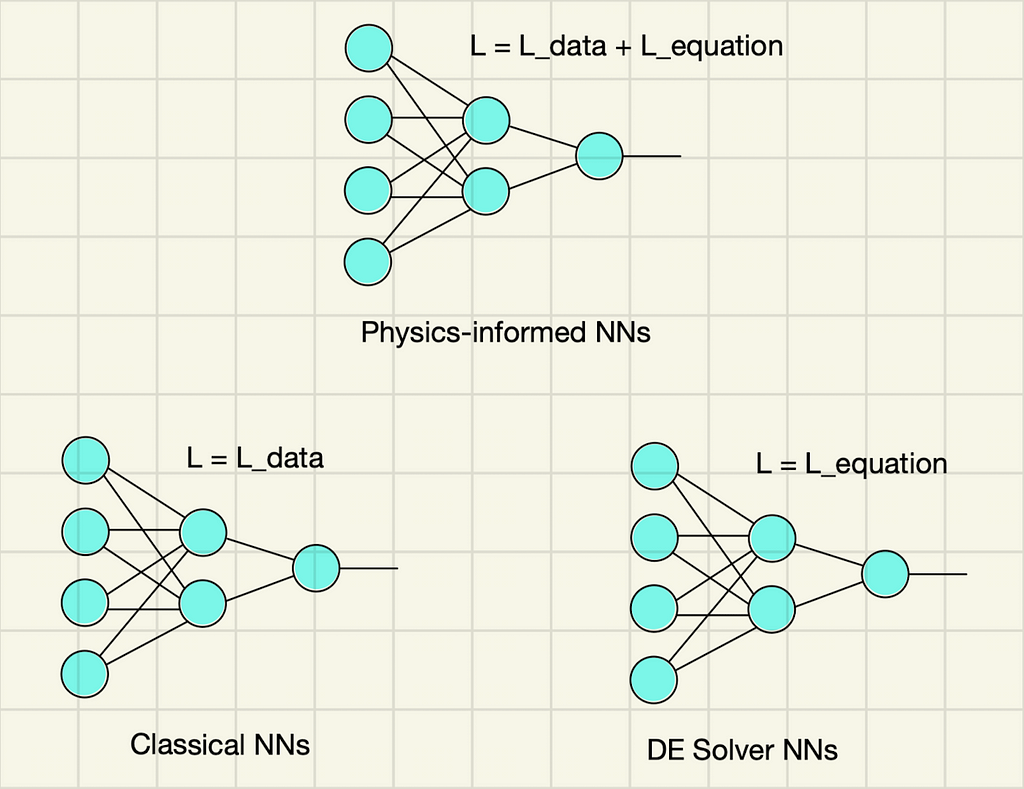
To showcase the theoretical learnings we’ve just got, I will implement the proposed solution in Python code, using the PyTorch library for machine learning.
The first thing to do is to create a neural network architecture:
import torch
import torch.nn as nn
class NeuralNet(nn.Module):
def __init__(self, hidden_size, output_size=1,input_size=1):
super(NeuralNet, self).__init__()
self.l1 = nn.Linear(input_size, hidden_size)
self.relu1 = nn.LeakyReLU()
self.l2 = nn.Linear(hidden_size, hidden_size)
self.relu2 = nn.LeakyReLU()
self.l3 = nn.Linear(hidden_size, hidden_size)
self.relu3 = nn.LeakyReLU()
self.l4 = nn.Linear(hidden_size, output_size)
def forward(self, x):
out = self.l1(x)
out = self.relu1(out)
out = self.l2(out)
out = self.relu2(out)
out = self.l3(out)
out = self.relu3(out)
out = self.l4(out)
return out
This one is just a simple MLP with LeakyReLU activation functions. Then, I will define the loss functions to calculate them later during the training loop:
# Create the criterion that will be used for the DE part of the loss
criterion = nn.MSELoss()
# Define the loss function for the initial condition
def initial_condition_loss(y, target_value):
return nn.MSELoss()(y, target_value)
Now, we shall create a time array that will be used as train data, and instantiate the model, and also choose an optimization algorithm:
# Time vector that will be used as input of our NN
t_numpy = np.arange(0, 5+0.01, 0.01, dtype=np.float32)
t = torch.from_numpy(t_numpy).reshape(len(t_numpy), 1)
t.requires_grad_(True)
# Constant for the model
k = 1
# Instantiate one model with 50 neurons on the hidden layers
model = NeuralNet(hidden_size=50)
# Loss and optimizer
learning_rate = 8e-3
optimizer = torch.optim.SGD(model.parameters(), lr=learning_rate)
# Number of epochs
num_epochs = int(1e4)
Finally, let’s start our training loop:
for epoch in range(num_epochs):
# Randomly perturbing the training points to have a wider range of times
epsilon = torch.normal(0,0.1, size=(len(t),1)).float()
t_train = t + epsilon
# Forward pass
y_pred = model(t_train)
# Calculate the derivative of the forward pass w.r.t. the input (t)
dy_dt = torch.autograd.grad(y_pred,
t_train,
grad_outputs=torch.ones_like(y_pred),
create_graph=True)[0]
# Define the differential equation and calculate the loss
loss_DE = criterion(dy_dt + k*y_pred, torch.zeros_like(dy_dt))
# Define the initial condition loss
loss_IC = initial_condition_loss(model(torch.tensor([[0.0]])),
torch.tensor([[1.0]]))
loss = loss_DE + loss_IC
# Backward pass and weight update
optimizer.zero_grad()
loss.backward()
optimizer.step()
Notice the use of torch.autograd.grad function to automatically differentiate the output y_pred with respect to the input t to compute the loss function.
After training, we can see that the loss function rapidly converges. Fig. 2 shows the loss function plotted against the epoch number, with an inset showing the region where the loss function has its fastest drop.
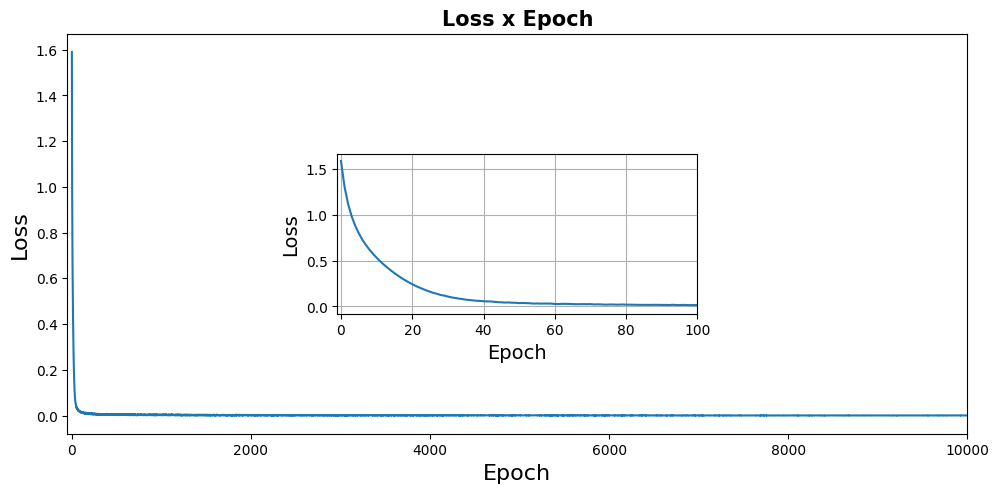
You probably have noticed that this neural network is not a common one. It has no train data (our train data was a hand-crafted vector of timestamps, which is simply the time domain that we wanted to investigate), so all information it gets from the system comes in the form of a loss function. Its only purpose is to solve a differential equation within the time domain it was crafted to solve. Hence, to test it, it’s only fair that we use the time domain it was trained on. Fig. 3 shows a comparison between the NN prediction and the theoretical answer (that is, the analytical solution).
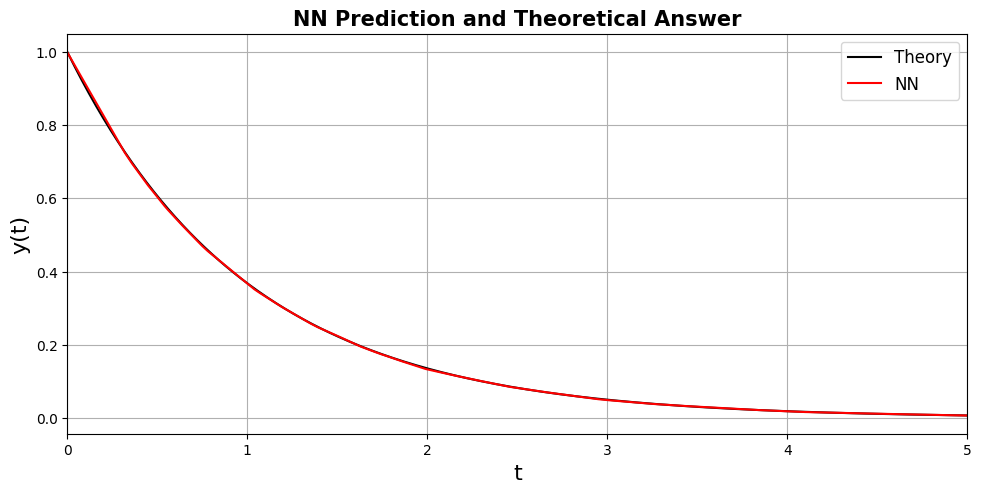
We can see a pretty good agreement between the two, which is very good for the neural network.
One caveat of this approach is that it does not generalize well for future times. Fig. 4 shows what happens if we slide our time data points five steps ahead, and the result is simply mayhem.
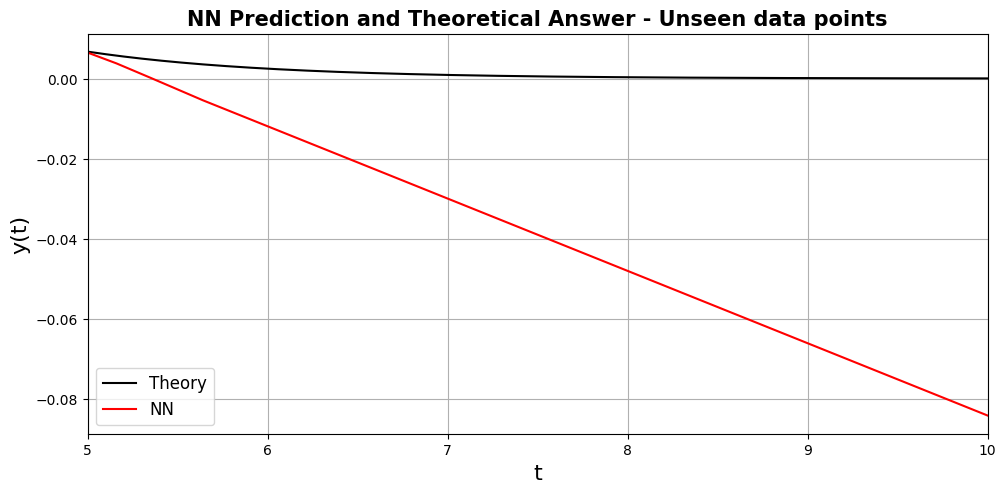
Hence, the lesson here is that this approach is made to be a numerical solver for differential equations within a time domain, and it should not be used as a regular neural network to make predictions with unseen out-of-train-domain data and expect it to generalize well.
After all, one remaining question is:
Why bother to train a neural network that does not generalize well to unseen data, and on top of that is obviously worse than the analytical solution, since it has an intrinsic statistical error?
First, the example provided here was an example of a differential equation whose analytical solution is known. For unknown solutions, numerical methods must be used nevertheless. With that being said, numerical methods for differential equation solving usually accumulate error. That means if you try to solve the equation for many time steps, the solution will lose its accuracy along the way. The neural network solver, on the other hand, learns how to solve the DE for all data points at each of its training epochs.
Another reason is that neural networks are good interpolators, so if you want to know the value of the function in unseen data (but this “unseen data” has to lie within the time interval you trained) the neural network will promptly give you a value that classic numeric methods will not be able to promptly give.
[1] Marios Mattheakis et al., Hamiltonian neural networks for solving equations of motion, arXiv preprint arXiv:2001.11107v5, 2022.
[2] Mario Dagrada, Introduction to Physics-informed Neural Networks, 2022.
Solving Differential Equations With Neural Networks was originally published in Towards Data Science on Medium, where people are continuing the conversation by highlighting and responding to this story.
Originally appeared here:
Solving Differential Equations With Neural Networks
Go Here to Read this Fast! Solving Differential Equations With Neural Networks


Understanding policy optimization and how it is used in reinforcement learning
Originally appeared here:
Policy Gradients: The Foundation of RLHF
Go Here to Read this Fast! Policy Gradients: The Foundation of RLHF
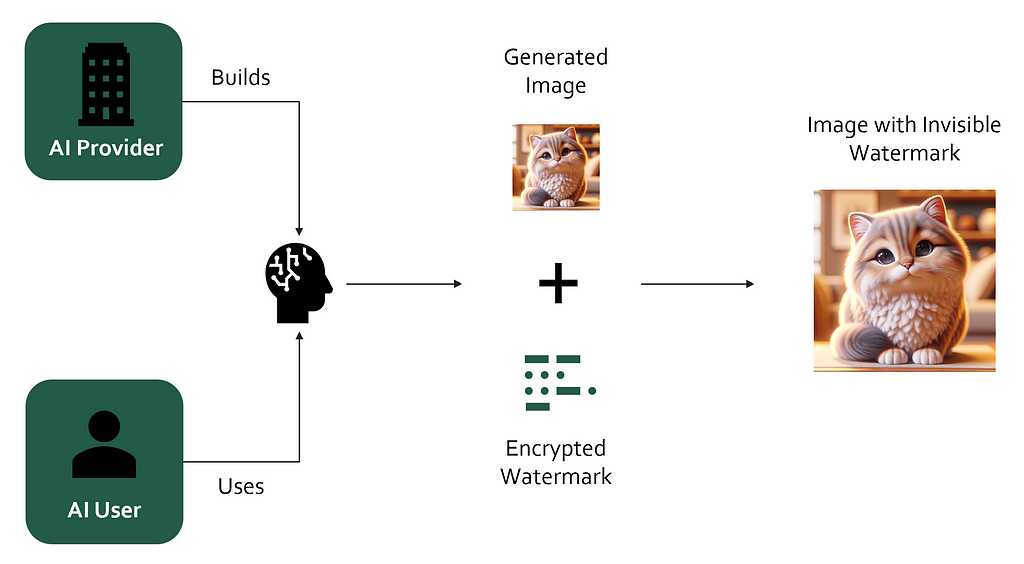
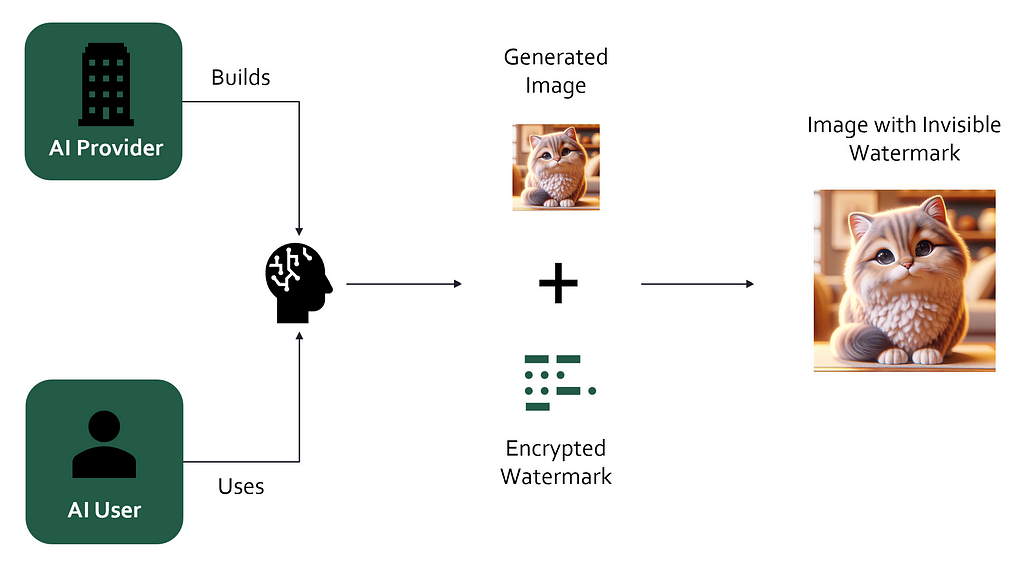

Watermarks are all over the internet — and for obvious reasons. How else could you protect your art or photography from ending up in someone’s PowerPoint presentation without crediting the creator? The simplest way of addressing this problem is to create visible watermarks like the one below.

The primary downside of this method is that it can compromise the art itself. No one would purchase and use the cat image like this. Therefore, while mitigating unauthorized copies, perceptible watermarks can also discourage the target audience from using the art.
In the music domain, perceptible watermarks are also common in free Hip-Hop beats. Beat producers often insert a voice sample with their brand name right before the first verse starts. This can serve either as a safeguard against illegal downloads or as a marketing tool when the beat is free-to-use.
For stock photos and Hip-Hop beats alike, a common practice is to place watermarks on the online previews and send the original product to clients after payment. However, this is also prone to misuse. As soon as the watermark-free product is purchased, it can be copied and reuploaded to the internet.
Imperceptible watermarks come with a distinct advantage: You can prove ownership over any digital copy of your product without negatively affecting product quality. It’s like a piece of paper with invisible ink on it. The paper is fully functional, but it carries a secret message that can be revealed at any time.

With this technology, creators can encode any kind of message within their works. More importantly, as they have access to the decoder, they can always assert ownership over any digital copy of their original work. Another emerging opportunity for rights-holders is to use web crawlers to search the web and report any detected misuse.
Another valuable application for imperceptible watermarks is for detecting AI-generated content. The advent of ChatGPT and similar AI tools has raised concerns about the potential overflow of dangerous AI-generated content on the internet. Tech companies like Meta or Google are bringing forward imperceptible watermarking systems as technological breakthroughs to mitigate this problem. Their tools can add watermarks to images or music without any noticeable change in quality.
In principle, this is a noteworthy development. With imperceptible watermarks, only the owner of the technology can decode and detect the presence of such watermarks. Using our example from above, Meta & Google own both the invisible ink and the means to reveal it. This allows them to accurately detect and filter content generated with their own tools on their platforms (e.g. Instagram, YouTube). Through collaborations, even independent platforms like X (former Twitter) could use this tech to limit AI-generated misinformation or other harmful content.
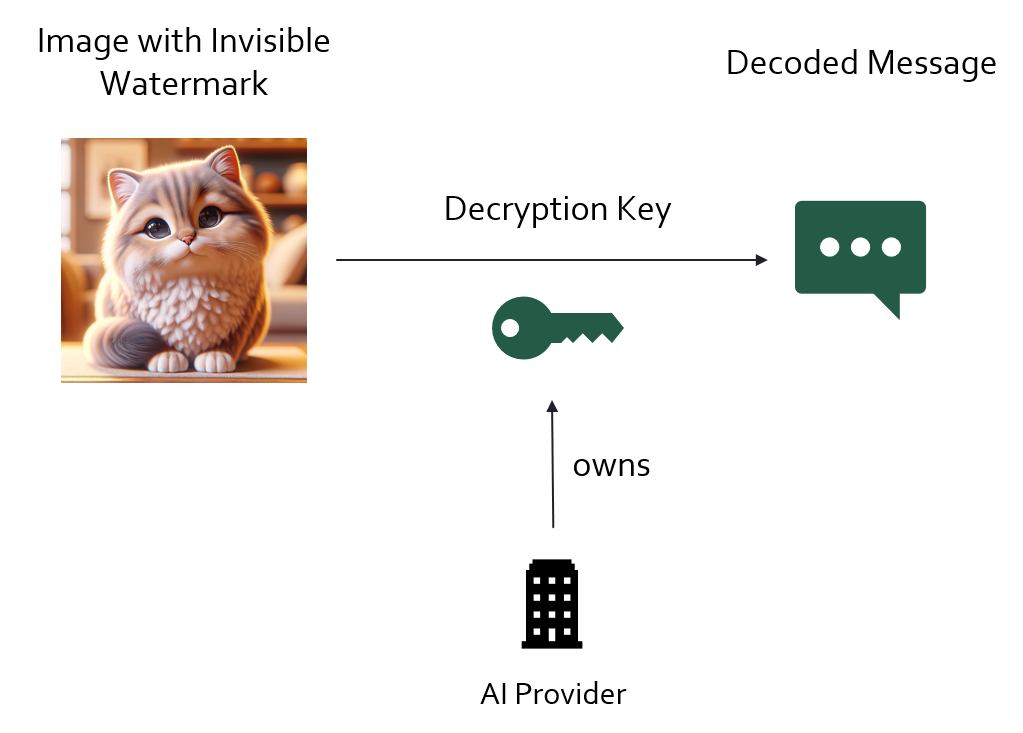
Although imperceptible watermarks sound promising and are being promoted by big tech companies, they are far from perfect. In fact, many of these watermarks can be reliably removed using smart AI algorithms. But how can AI remove something that is imperceptible?
Let’s start by understanding how perceptible watermarks can be removed with AI. Let me propose a simple approach: Start by collecting hundreds of thousands of images from the web. Then, automatically add artificial watermarks to these images. Make sure they resemble real watermarks and cover a wide variety of fonts, sizes, and styles. Then, train an AI to remove watermarks by repeatedly showing it pairs of the same image — once with and once without the watermark.
While there are certainly more sophisticated approaches, this illustrates the ease with which watermarks can be removed if the AI is trained to recognize their appearance or sound. There are numerous tools online that allow me to easily remove the watermark from my cat image above:

To employ this simple approach from above, you need to provide the AI with the “before and after” examples. However, if the watermarks are imperceptible, how can find these examples? Even worse, we can’t even tell if a watermark is present or not just by looking at an image or listening to a song.
To solve this problem, researchers had to get creative. Zhao et al., 2023 came up with a two-stage procedure.
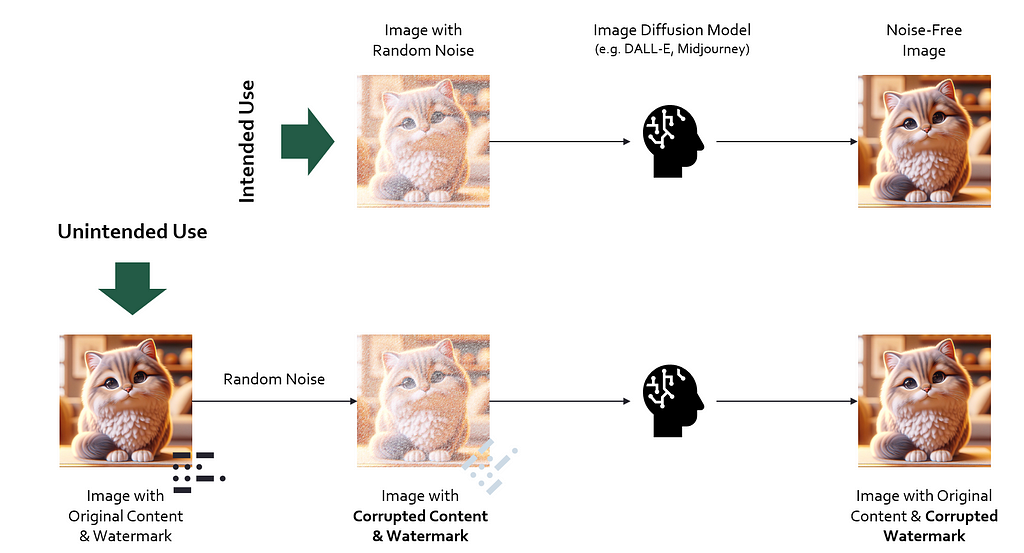
This is brilliant, because it challenges the intuition that, in order to remove a watermark, you must be able to detect it. This approach can’t locate the watermark. However, if the only goal is to remove the watermark, simply destroying it by adding enough white noise to the image is quick and effective.
Of course, after adding noise, you might have broken the watermark, but you end up with a noisy picture. The most fascinating part is how the authors then reconstructed the original image from the noise. For that, they used AI diffusion models, such as the ones used in DALL-E 3 or Midjourney. These models generate images by iteratively turning random noise into realistic pictures.

As a side effect, diffusion models are also incredibly effective denoising systems, both for images and for audio. By leveraging this technology, anyone can remove imperceptible watermarks using this exact two-step procedure.

Yes and no. On the one hand, it seems likely that any imperceptible watermarking system invented so far can be broken by bad actors through one method or the other. When I posted about this problem on Linkedin for the first time, one person commented: “It’s the adblocker blocker blocker game all over again”, and I couldn’t agree more.
The obvious defence against the attack approach proposed by Zhao et al. (2023) is to develop an invisible watermarking system that is robust to it. For instance, we could train our watermarking system in a way that current SOTA diffusion models cannot reconstruct the image well after removing the watermark with random noise. Or we could try to build a watermark that is robust to random noise attacks. In either case, new vulnerabilities would quickly be found and exploited.
So are imperceptible watermarks simply useless? In a recent article, Sharon Goldman argues that while watermarks might not stop bad actors, they could still be beneficial for good actors. They are a bit like metadata, but encoded directly into the object of interest. Unlike MP3 metadata, which may be lost when the audio is converted to a different format, imperceptible watermarks would always be traceable, as they are embedded directly in the music itself.
However, if I am honest with myself, I was hopeful that imperceptible watermarks could be a viable solution to flagging and detecting AI-generated content. Apparently, I was wrong. These watermarks will not prevent bad actors from flooding the internet with harmful AI-generated content, by and large.

As highlighted above, developing countermeasures to known attack algorithms is always an option. In many cases, however, it is easier for the attackers to iterate on their attack algorithms than for the defenders to develop safeguards. Still, we can’t neglect the possibility that we might discover a new approach to watermarking that isn’t as easily breakable. It is therefore definitely worth investing time and resources into further research on this topic.
While generating images with AI and uploading them to a social media platform is generally not considered illegal, purposefully removing watermarks from AI-generated images could very well be. Having no legal expertise myself, I can only argue that it would make sense to threaten legal consequences against such malicious actions.
Of course, the normal users resharing images they found online should be excluded from this. However, purposefully removing watermarks to spread misinformation is clearly immoral. And even if legal pressure will not eradicate misuse (it never has), it can be one mitigating factor.
Many approaches exist around how blockchain technology and/or smart contracts could help prove ownership in the digital age. A blockchain, in simple terms, is a information storage that tracks interactions between members of a network. Each transaction can be uniquely identified and can’t be manipulated at any later point in time. Adding smart contracts to this network allows us to connect transactions to binding responsibilities that are automatically fulfilled once the transaction is done.
In less abstract terms, blockchains and smart contracts could be used in the future to automate ownership checks or royalty payments for intellectual property in any shape or form. So far, no such system has found widespread adoption. Still, we might be only a few technical breakthroughs away from these technologies becoming invaluable assets in our economies.
Digital watermarks have been used since the the early days of the internet to prevent misuse of intellectual property such as images or music. Recently, it has been discussed as a method for flagging and detecting AI generated content. However, it turns out that AI is not only great at generating fake images. It is just as good at removing any kind of watermark on these images, rendering most detection systems useless.
It is clear that we can’t let this discourage us in searching for alternative ways of proving ownership in the age of AI. By developing concrete technical and legal countermeasures and, at the same time, exploring how blockchains and/or smart contracts could be leveraged in the future, we might just figure out how to solve this important problem.
Zhao et al., 2023. Invisible Image Watermarks Are Provably Removable Using Generative AI. https://arxiv.org/pdf/2306.01953.pdf
I’m a musicologist and a data scientist, sharing my thoughts on current topics in AI & music. Here is some of my previous work related to this article:
Find me on Medium and Linkedin!
How AI Can Remove Imperceptible Watermarks was originally published in Towards Data Science on Medium, where people are continuing the conversation by highlighting and responding to this story.
Originally appeared here:
How AI Can Remove Imperceptible Watermarks
Go Here to Read this Fast! How AI Can Remove Imperceptible Watermarks



For a limited time, pick up a lifetime subscription to Babbel’s language learning platform at the heavily reduced price of $149.97. This Deal of the Week is within $20 of the lowest price on record for the All Languages Babbel subscription that provides users with access to 14 different languages.
Go Here to Read this Fast! ISS private astronaut shares stunning Earth photos
Originally appeared here:
ISS private astronaut shares stunning Earth photos
Can you imagine having to mail in a $3,499 gadget because you forgot the passcode you nominated to be able to use it? Customers who purchased the Apple Vision Pro may have to do just that if they forget their device’s passcode. According to Bloomberg, the company has been telling buyers that the only way to reset their codes is to go to an Apple Store or to mail their mixed reality headset to AppleCare customer support. Apple will then reset their codes so they could use their device again.
As Bloomberg notes, if a user enters an incorrect code too many times, their device will be disabled and they’ll have to sit through a waiting period to be able to try again. They’ll have to get Apple to reset their code if they still can’t recall it after that waiting period, and getting the company to do will erase all the content on their headset.
It’s worth noting that some users on the Apple discussion forum still got locked out even though they entered the correct passcode — it’s unclear if it’s a bug affecting some units — so the issue could happen to anyone. Based on some other posts, Apple’s Genius Bar personnel use an accessory called the Developer Strap that the company is selling to developers for $299 to connect the headset to iPads or laptops to be able to reset it. In at least one instance, Apple Geniuses reportedly failed to reset the user’s headset and had to replace it altogether.
The process to change the headset’s passcode could still change in the future — the recently released Vision Pro, after all, is the first iteration of a brand new product category. For the sake of those who’ve already purchased one, we hope it’s introduced through a software update instead of as an improvement in the next version.
This article originally appeared on Engadget at https://www.engadget.com/apple-vision-pro-users-will-have-to-go-to-a-store-to-reset-forgotten-passcodes-070101287.html?src=rss
Originally appeared here:
Apple Vision Pro users will have to go to a store to reset forgotten passcodes
Currently serving over 70 million daily active users, Roblox is still going strong since its September 2006 launch — almost 18 years ago. The development team is now taking one step further to boost the platform’s massive community, by way of providing real-time AI chat translation to connect gamers around the world. According to CTO Daniel Sturman, his team needed to build their own “unified, transformer-based translation LLM (large language model)” in order to seamlessly handle all 16 languages supported on Roblox, as well as to recognize Roblox-specific slangs and abbreviations (this writer just learned that “obby” refers to an obstacle course in the game).
As a result, the chat window always displays the conversation in the user’s own tongue — with a small latency of around 100 milliseconds, so it’s pretty much real time. You can also click on the translation icon on the left of each line to see it in its original language. Sturman claims that thanks to the language model’s efficient architecture and iterative training, it “outperforms commercial translation APIs on Roblox content.” The development team will later roll out a feedback tool to help improve translation quality, in addition to its ongoing updates with whatever new catchphrases it picks up on the platform.
Roblox’s translation efforts don’t stop there. Sturman adds that his team is already looking into automatically translating “text on images, textures, 3D models” and more. As Roblox supports voice chat, the exec also teases the possibility of automatic voice chat translations, so gamers from around the world can seamlessly talk to one another in their own tongue on the platform. Given that Samsung already offers a similar feature via Galaxy AI, it probably won’t be long before we hear another update from Roblox on this end.
This article originally appeared on Engadget at https://www.engadget.com/roblox-adds-real-time-ai-chat-translation-using-its-own-language-model-061929902.html?src=rss
Go Here to Read this Fast! Roblox adds real-time AI chat translation using its own language model
Originally appeared here:
Roblox adds real-time AI chat translation using its own language model



One of the longest-standing pieces of skeuomorphism on your Mac is the Trash, and it functions exactly the same as its real-world counterpart. You can fill it up with all sorts of junk you don’t want or need anymore, but you will eventually have to empty it out. Unlike your actual trash can, Trash in macOS Sonoma can be made more convenient.
Go Here to Read this Fast! How to use Trash on macOS Sonoma
Originally appeared here:
How to use Trash on macOS Sonoma
Go Here to Read this Fast! You really do not want to forget your Vision Pro passcode
Originally appeared here:
You really do not want to forget your Vision Pro passcode